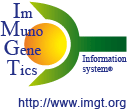IMGT allele nomenclature for sequence polymorphisms
Lefranc, M.-P. "IMGT Locus on Focus: A new section of Experimental and Clinical Immunogenetics", Exp. Clin. Immunogenet., 15, 1-7 (1998)
Lefranc, M.-P. et al., Nucleic Acids Research, 27, 209-212 (1999)
Lefranc M-P. Immunoglobulin (IG) and T cell receptor genes (TR): IMGT® and the birth and rise of immunoinformatics. Front Immunol. 2014 Feb 05;5:22. doi: 10.3389/fimmu.2014.00022. Open access PMID: 24600447
IMGT allele name nomenclature for IG and TR of all vertebrates
IMGT general rules
Alleles are described, exhaustively and in a standardized way, for the four "core" coding regions, that is the germline V-REGION, D-REGION, and J-REGION, and for the C-REGION, from IG and TR of all vertebrate species with jaws (gnathostomata). These alleles refer to sequence polymorphisms, with mutations described at the sequence level.
Polymorphic sequence mutations which concern parts of the gene (including untranslated exons) are not studied systematically and are only reported in the sequence flat files.IMGT allele names
- Allele names of the V-REGION, D-REGION, J-REGION and C-REGION comprise the IMGT gene name followed by an asterisk and a two-figure number. The V-REGION, D-REGION, J-REGION and C-REGION selected as references for the allele polymorphism description have the number *01; other alleles are designated by increasing numbers (*02, *03, ...) based, if possible, on chronological order of their publication, and/or confirmation of data by different authors.
- Note that the number *01 does not mean necessarily that other alleles are already known, but it signifies that any new polymorphic
sequence will be described by comparison to that allele *01.
The number of alleles for IG and TR V-REGION, D-REGION, J-REGION or C-REGION, is shown in the Alignments of alleles and Tables of alleles (see below). - Allele names are defined at the "species" level.
IMGT allele description and representations
Allele mutation description and numbering
Allele polymorphism mutations are described according to IMGT description of mutations.
- Allele mutation numbering of the V-REGION follows the IMGT unique numbering which allows a standardized description of allele polymorphism mutations for all germline IG and TR V-REGION of all species. Note that mutations of the 1 (or 2) nucleotide(s) following the last codon (if present) define new alleles and are shown in the Alignments of alleles, but are not reported in the Tables of alleles.
- D-REGION alleles are only described at the nucleotide level since D-REGION can be used in the three reading frames. The D-REGION allele mutation numbering starts with the first nucleotide downstream from the 5'D-HEPTAMER.
- J-REGION allele mutation numbering starts with the first nucleotide of the first codon. Note that mutations of the 1 (or 2) nucleotide(s) preceding the first codon (if present) define new alleles and are shown in the Alignment of alleles, but are not reported in the Table of alleles. The nucleotide "n" of the DONOR-SPLICE n/gt of the germline J-REGION, if mutated, also defines new allele(s) shown in the Alignments of alleles, but are not reported in the Tables of alleles.
- The C-REGION allele polymorphisms are described by comparison to a cDNA reference sequence.
The exon allele mutation numbering starts with the first nucleotide of the first codon which results from the splicing
(this nucleotide is the nucleotide "n" of the DONOR-SPLICE
n/gt of the germline J-REGION).
The numbering of the region encoded by individual exons starts with the first nucleotide of the first codon which results from the splicing. - For sequence and structure comparison and for allele description between different C domains, the IMGT unique numbering for C-DOMAIN has been set up.
Allele representations
Two representations of alleles are available :
- The Tables of alleles which report the description of the nucleotide mutations and corresponding amino acid changes of the different alleles, by comparison to the allele*01. Nucleotide mutations and corresponding amino acid changes for a given codon are shown in a single subdivision, separated by a comma.
- The Alignments of alleles which display the alignments of all known sequences assigned to the different alleles, by comparison to the allele*01. The translation of the allele*01, and the nucleotide mutations and corresponding amino acid changes of the other alleles are shown. Dashes indicate identical nucleotides. Dots indicate gaps according to the IMGT numbering.
- Due to the usual absence of somatic hypermutations in V-REGION from T cell receptors (TR), rearranged genomic DNA or cDNA can be found included in the Alignments of alleles and Tables of alleles, when the corresponding germline gene has not yet been isolated. Note that nucleotide mutations and amino acid changes in the CDR3-IMGT of these TR V-REGION are shown in black in Alignments of alleles and are not taken into account for the description of polymorphisms in Tables of alleles.
- Nucleotide and amino acid typing or sequencing errors, detected by IMGT curators, are shown in italics and/or black in the Alignments of alleles. They are not reported in Tables of alleles.
Definitive allele designation
Definitive allele designation, confirmed by genetic studies and/or different sources of data is indicated by "+" in the Tables of alleles.
IMGT reference directory
The IMGT reference directory is constituted by sets of sequences which contain the V-REGION, D-REGION and J-REGION alleles, isolated from the Functional and ORF IMGT reference sequences.
By definition, these sets contain one sequence for each allele. Allele names of these sequences are shown in red in Alignments of alleles.
The IMGT reference directory is used to analyse the IG and TR sequences and is crucial for the high quality of IMGT/V-QUEST results (See also IMGT/V-QUEST Documentation). To download the IMGT reference directory in FASTA format, click here
Somatic hypermutations
Somatic hypermutations of the rearranged variable regions can be described when the corresponding germline V-REGION, D-REGION and J-REGION alleles have been identified.
The IMGT unique numbering allows a standardized description of somatic hypermutations of rearranged variable genes.
- Allele (IMGT Index)
- IMGT gene name nomenclature for IG and TR of human and other vertebrates (IMGT Scientific chart)
- IMGT Locus in Focus (IMGT Index)
- IMGT Nomenclature Committee (IMGT-NC) (IMGT Index)
- IUIS Immunoglobulins (IG), T cell Receptors (TR) and Major Histocompatibility (MH) Nomenclature Sub-Committee (IMGT-NC) (IMGT Index)
- How to propose new IG or TR gene names to IMGT? (IMGT FAQ General)



